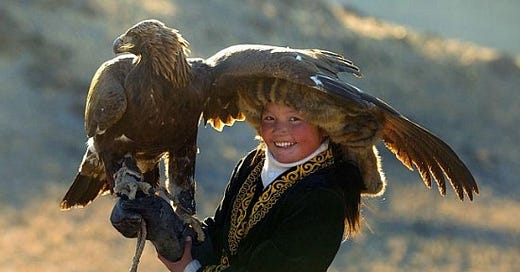The Eagle Huntress

Aisholpan is a pretty typical 13-year-old kid. She likes prattling with her friends, putting on fingernail polish and bragging about out-wrestling all of the boys in her class. Her mom’s on the traditional side and worries about her being too bold and reaching too high, but her father is very proud and supportive, constantly encouraging her to pursue her dreams.
The difference, of course, is that Aisholpan lives in Mongolia on the steppes of the fierce Altai mountains, and her dream is to become an eagle hunter — the first female to do so in a tradition dating back hundreds of years.
This new documentary, directed by Otto Bell and narrated by Daisy Ridley, follows Aisholpan over the course of several months as she strives to learn the ways of her forefathers, who were elite eagle hunters going back generations. Her dad was even twice champion at the annual Eagle Festival, where dozens of the best gather to compete in a series of competitions.
The film is an eclectic step back in time, watching these people exist much as they did a hundred years ago, living in fur-lined tents on the plains, riding horses and hunting for foxes and other mountain critters. They train the eagles to swoop down upon the beasts, procuring the precious meat and fur to their human masters.
Bell employs a lot of impressive camerawork (cinematography by Simon Niblett), including drone photography, to capture the mighty birds in flight, often looking down upon the yawning expanse of the Mongolian plains below. This is well complemented by Jeff Peters’ thrumming musical score.
There is some conflict about Aisholpan being a gender pioneer, which Bell milks for every ounce (perhaps overplaying at times). Elder eagle hunters tut-tut and offer their archaic wisdom — “Women are meant to stay indoors and quarrel for the catch,” one says — but no serious effort to discourage her ever arises. She’s even allowed to compete in the Eagle Festival, making quite the impression.
Probably the most thrilling section is capturing her bird. The Altai hunters must personally climb into the nest of some eaglets and spirit one away before the mother bird returns. Watching Aisholpan scramble down an unstable mountainside, we are awed by this rite of passage.
Some might fret about the hunters exploiting the eagles, but they seem to share a largely symbiotic relationship. Aisholpan hand-feeds her bird until it’s old enough to fly on its own, cementing the bond. They are fawned and revered like an honored guest. Otto also opens the film with a wizened hunter releasing his eagle back into the wild after years of service — something mandated by their traditions.
“The Eagle Huntress” is less a straight journalistic exploration and more a celebration of one girl’s journey into womanhood, and history. With her strong, broad face and unflappable courage, Aisholpan has broken her nation’s last proverbial glass ceiling, leaving a heavenly sky open to all possibilities.



